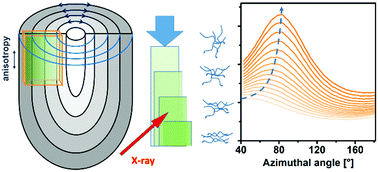Insight into the nanostructure of anisotropic cellulose aerogels upon compression†
Abstract
Cellulose II aerogels are a highly porous class of biobased ultra-light-weight materials. They consist of interlinked networks of loosely aggregated cellulose fibrils. The latter typically have random orientation due to spontaneous phase separation triggered by addition of antisolvent to moleculardisperse cellulose solutions. Deceleration of phase separation has been recently proposed as a novel approach towards aerogels featuring preferred cellulose orientation. Here, we investigate the mechanical response of such oriented cellulose aerogels towards load up to 80% compression. Stress–strain curves were recorded and in situ small angle X-ray scattering (SAXS) was performed during compression test to obtain information about the structural alterations of the aerogel fibril networks on the nano-scale related to deformation. Using SAXS in addition, structural changes can be followed in much more detail than by recording stress–strain curves alone. Buckling and coalescence of fibers and a change in fibril orientation can be related to certain regimes in the stress–strain curve. If the loading axis is oriented parallel to the network orientation the aerogels show higher resilience towards the compression.



 Please wait while we load your content...
Please wait while we load your content...